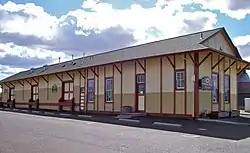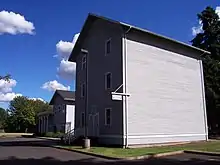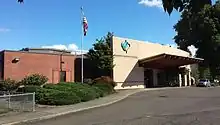Lebanon, Oregon | |
|---|---|
 Former railroad station in downtown Lebanon | |
| Motto: "The town that friendliness built"[1] | |
 Location in Oregon | |
| Coordinates: 44°31′54″N 122°54′25″W / 44.53167°N 122.90694°W | |
| Country | United States |
| State | Oregon |
| County | Linn |
| Incorporated | 1878 |
| Government | |
| • Mayor | Kenneth Jackola[2] |
| Area | |
| • Total | 7.25 sq mi (18.79 km2) |
| • Land | 7.02 sq mi (18.19 km2) |
| • Water | 0.23 sq mi (0.60 km2) |
| Elevation | 348 ft (106 m) |
| Population | |
| • Total | 19,690 |
| • Density | 2,626.66/sq mi (1,014.17/km2) |
| Time zone | UTC-8 (Pacific) |
| • Summer (DST) | UTC-7 (Pacific) |
| ZIP code | 97355 |
| Area code | 541 |
| FIPS code | 41-41650[6] |
| GNIS feature ID | 2410815[4] |
| Website | www |
Lebanon (/ˈlɛbənən/ LEB-ən-ən) is a city in Linn County, Oregon, United States. Lebanon is located in northwest Oregon, southeast of Salem. The population was 19,690 at the 2020 census. Lebanon sits beside the South Santiam River on the eastern edge of the Willamette Valley, close to the Cascade Range and a 25-minute drive to either of the larger cities of Corvallis and Albany. Lebanon is known for its foot-and-bike trails, its waterside parks, and its small-town character.
Demographics
| Census | Pop. | Note | %± |
|---|---|---|---|
| 1880 | 270 | — | |
| 1890 | 829 | 207.0% | |
| 1900 | 922 | 11.2% | |
| 1910 | 1,820 | 97.4% | |
| 1920 | 1,805 | −0.8% | |
| 1930 | 1,851 | 2.5% | |
| 1940 | 2,729 | 47.4% | |
| 1950 | 5,873 | 115.2% | |
| 1960 | 5,858 | −0.3% | |
| 1970 | 6,636 | 13.3% | |
| 1980 | 10,413 | 56.9% | |
| 1990 | 10,950 | 5.2% | |
| 2000 | 12,950 | 18.3% | |
| 2010 | 15,518 | 19.8% | |
| 2020 | 19,690 | 26.9% | |
| Sources:[6][7][8][9][10][5] | |||
2010 census
As of the census[6] of 2010, there were 15,518 people, 6,118 households, and 3,945 families residing in the city. The population density was 2,326.5 inhabitants per square mile (898.3/km2). There were 6,820 housing units at an average density of 1,022.5 per square mile (394.8/km2). The racial makeup of the city was 91.2% White, 0.5% African American, 1.4% Native American, 1.1% Asian, 0.1% Pacific Islander, 2.1% from other races, and 3.7% from two or more races. Hispanic or Latino of any race were 5.8% of the population.
There were 6,118 households, of which 33.5% had children under the age of 18 living with them, 44.6% were married couples living together, 14.3% had a female householder with no husband present, 5.6% had a male householder with no wife present, and 35.5% were non-families. 28.5% of all households were made up of individuals, and 14.3% had someone living alone who was 65 years of age or older. The average household size was 2.50 and the average family size was 3.05.
The median age in the city was 36.6 years. 25.7% of residents were under the age of 18; 9.4% were between the ages of 18 and 24; 24.9% were from 25 to 44; 23.6% were from 45 to 64; and 16.3% were 65 years of age or older. The gender makeup of the city was 47.7% male and 52.3% female.
Geography

According to the United States Census Bureau, the city has a total area of 6.87 square miles (17.79 km2), of which 6.67 square miles (17.28 km2) is land and 0.20 square miles (0.52 km2) is water.[11]
Climate
This region experiences warm (but not hot) and dry summers, with no average monthly temperatures above 71.6 °F (22.0 °C). According to the Köppen Climate Classification system, Lebanon has a warm-summer Mediterranean climate, abbreviated "Csb" on climate maps.[12]
Economy
Lowe's Regional Distribution Center is the largest employer in Lebanon, with 650 employees. The other major employers are Samaritan Lebanon Community Hospital, Lebanon Schools, Wal-Mart, Weyerhaeuser, and Entek International.[13][14]
Education
.jpg.webp)
Lebanon is served by the Lebanon Community Schools public school district, which includes Lebanon High School. It is also home to the private East Linn Christian Academy, which serves students from preschool through twelfth grade (PreK-12).
Western University of Health Sciences opened their College of Osteopathic Medicine of the Pacific, Northwest in August 2011, the first new medical school in Oregon since Oregon Health & Science University was established.[15] The school opened with 107 students.
In 2017, Linn-Benton Community College opened its HealthCare Occupations Center beside the osteopathic college.
In 2021, Western University of Health Sciences opened its College of Health Sciences for students of physical therapy.
History
In 1847, Jeremiah and Jemima Ralston bought a pioneers' cabin, staked a claim, and built a log house on a low rise at what is now Ralston Park. Nearby, on today's Main Street, they built a store. It soon became a stop for gold seekers on their way to California. A village grew up around the store, and in 1855 the couple filed a plat for the town, naming it for Jeremiah's birthplace of Lebanon, Tennessee. They also donated land for the Santiam Academy, which the Methodist Episcopal Church operated until 1906.
Lebanon was established on the land of the Louis Band of the Santiam Kalapuya.Like other Kalapuya tribes, the Santiam had dwindled in number, from malaria and other diseases, before the Americans arrived. In 1855, the band sold the U.S. government their rights to the land and moved to a temporary reservation on a claim belonging to the Ralstons' son, just south of their own. There the band awaited removal to the Grand Ronde Valley.
In 1859, local men in search of a way to drive cattle to central Oregon discovered the Santiam Pass. Soon Lebanon found itself on another essential trade route. Linn County stockmen incorporated the Willamette Valley and Cascade Mountain Road in 1864, and vacationers as well as stockmen came to rely on what came to be called the Santiam Wagon Road. This toll road was later replaced with U.S. Highway 20.
Transportation was often easier by water than land in the early decades of American settlement in the Willamette Valley. The South Santiam River was too shallow for large boats, so in 1872 construction began on a canal to carry barges laden with goods between Lebanon and Albany. But the water flowed too fast for upstream shipping, and the coming of the railroad curtailed downstream shipping. Today, however, the canal is still in use, running through Lebanon backyards to provide water for the people of Albany.
Railroads helped Lebanon provide its goods not only to Albany but to the world. The Albany–Lebanon Railroad, completed in 1880, was a branch of the Oregon and California Railroad's north–south line through Albany. The Southern Pacific eventually took over these lines and, in 1910, rerouted the old Oregonian line through Lebanon.
From the 1890s on, a great variety of farming and food-processing industries flourished in the area. Eastern Oregon came to dominate in wheat growing, but Lebanon-area farmers produced orchard fruits, berries, walnuts, filberts, hops, flax, vegetables, forage crops, turkeys, mohair, honey, and flowers for florists. Lebanon had a cheese factory, a creamery, potato warehouses, a cannery, and prune and nut driers. In the 1920s, the local grass-seed industry got its start, and by the 1930s Linn County was the leading county in grass-seed production in the United States.
Lebanon's most celebrated crop has been strawberries. By 1907, Lebanon was one of the leading strawberry-growing areas in the Willamette Valley. Lebanon's Strawberry Festival – featuring, since 1931, "the World's Largest Strawberry Shortcake" – has been an annual event since 1909. As of 2020, however, only one local strawberry field remains.
The local wood-products industry began to grow around 1900, which the supply of timber in the upper Midwest declined. The industry began to boom when the Oregon and Electric Railroad was completed, in 1932. New sawmills were built along the line in town as well as in the mountains. From 1937 to 1942, twenty new mills opened in the city; they made a great variety of wood products. The paper mill, which had originally made paper from wheat straw, doubled in size in 1936 to process logs that were floated down the South Santiam River. The local population swelled, and the Great Depression had little effect on the city.
In 1940, a still greater boom began. That year, Evans Products built what was purported to be the biggest plywood mill in the world. "Evansville" became a station on the Oregon and Electric line. World War II increased the demand for plywood, and women took men's places in the mill. From 1940 to 1950, Lebanon's population grew by 115 percent.
In 1952, the plywood plant, now called Cascade Plywood, began producing Lebanite, a hard composite board. Lebanon residents began calling themselves Lebanites. Cascade Plywood came to dominate Lebanon's economy.
Lebanon's economy began a slow decline in the 1970s. As overharvesting in the nearby forests made timber extraction more expensive, the mills began closing. Lebanon's paper mill closed in 1980, the plywood mill in 1984, and the Lebanite hardwood plant in 2004. Weyerhaeuser shut down the last of the big mills in 2006 and 2007. Unemployment rocketed, and Main Street storefronts were left empty.
In the twenty-first century, the city's economy has improved. The openings of the College of Osteopathic Medicine of the Pacific Northwest, in 2011, the Edward C. Allworth Veterans' Home, in 2017, and Linn-Benton Community College's HealthCare Occupations Center, in 2017, have sparked growth. Weyerhaeuser opened the state-of-the-art Santiam Lumber sawmill in 2008, only one year after closing down the old Bauman sawmill. Main Street storefronts and old houses are being renovated, and brewpubs, bakeries, and other new businesses are thriving.
Arts and culture
Annual cultural events
Lebanon is the home of the World's Largest Strawberry Shortcake, a part of the annual Strawberry Festival that began in 1909. The Strawberry Festival includes a Junior Parade, a Grand Parade (featuring the Strawberry Royalty Court), and a carnival. It is held the first weekend of June.
Recreation
Parks
The city has 15 developed parks, totaling 71.5 acres (28.9 ha), which provide residents with baseball, softball, and soccer fields, as well as playgrounds, basketball and tennis courts, and other resources. Gills Landing has a boat ramp and dock, as well as an RV park, camping area, and showers.[16] Ralston Park hosts the town's Christmas tree and yearly lighting celebration.
Trails
A local nonprofit organization, Build Lebanon Trails, is working with the city government to build more than fifty miles (80 km) of walking and biking trails in Lebanon.
Notable people
- David W. Ballard (1824–1875), governor of Idaho territory
- Carson "Skeeter" Bigbee (1895–1964), professional baseball outfielder
- Eric Castle (1970–), former NFL safety and special teams player for the San Diego Chargers
- Jo Collins (1945–), actress and 1965 Playmate of the Year
- Warren C. Gill (1912–1987), Coast Guard veteran, Oregon State Representative and State Senator
- Howard Hesseman (1940–2022), actor
- Ben Howland (1957–), college basketball coach
- Pat McQuistan (1983–), offensive lineman for the Arizona Cardinals
- Paul McQuistan (1983–), offensive lineman for the Seattle Seahawks
- Tom Medley (1920–2014), cartoonist (creator of Stroker McGurk) and magazine editor
- Michael Merzenich (1942–), world-renowned neuroscientist
- Katherine Ann Power (1949–), former fugitive for manslaughter and armed robbery
- Doug Riesenberg (1965–), former NFL offensive tackle
- Dave Roberts (1951–), MLB third baseman
- Mike Royer (1941–), comic book artist at Marvel and DC Comics
- Dick Smith (1939–2012), MLB outfielder and first baseman
References
- ↑ Jon Nelson. "City Manager". City of Lebanon. Archived from the original on May 23, 2013. Retrieved May 25, 2013.
- ↑ https://www.ci.lebanon.or.us/citycouncil/page/mayor-kenneth-jackola
- ↑ "ArcGIS REST Services Directory". United States Census Bureau. Retrieved October 12, 2022.
- 1 2 U.S. Geological Survey Geographic Names Information System: Lebanon, Oregon
- 1 2 "Census Population API". United States Census Bureau. Retrieved October 12, 2022.
- 1 2 3 "U.S. Census website". United States Census Bureau. Retrieved December 21, 2012.
- ↑ "Population-Oregon" (PDF). U.S. Census 1910. U.S. Census Bureau. Retrieved November 22, 2013.
- ↑ "Population-Oregon" (PDF). 15th Census of the United States. U.S. Census Bureau. Retrieved November 27, 2013.
- ↑ "Number of Inhabitants: Oregon" (PDF). 18th Census of the United States. U.S. Census Bureau. Retrieved November 22, 2013.
- ↑ "Pennsylvania: Population and Housing Unit Counts" (PDF). U.S. Census Bureau. Retrieved November 22, 2013.
- ↑ "US Gazetteer files 2010". United States Census Bureau. Archived from the original on July 2, 2012. Retrieved December 21, 2012.
- ↑ "Lebanon, Oregon Koppen Climate Classification". Weatherbase. Retrieved February 9, 2022.
- ↑ "Fact Sheet: Lebanon Oregon". City of Lebanon. Archived from the original on March 4, 2016. Retrieved September 26, 2013.
- ↑ "About ENTEK - History". Archived from the original on August 31, 2013. Retrieved December 3, 2013.
- ↑ Budnick, Nick (July 31, 2011). "Osteopathic medical school to open next week in Lebanon, Oregon". The Oregonian. Portland, Oregon. Retrieved August 1, 2011.
- ↑ "Lebanon Parks Master Plan". City of Lebanon. Archived from the original on March 3, 2016. Retrieved November 5, 2013.
External links
 Media related to Lebanon, Oregon at Wikimedia Commons
Media related to Lebanon, Oregon at Wikimedia Commons- Entry for Lebanon in the Oregon Blue Book
- City of Lebanon website
- Chamber of Commerce
- Lebanon Express newspaper
- Lebanon Local newspaper
- Historic photos of Lebanon from Salem Public Library[h
- Lewis, David. "The 1851 Treaty Commission Journal: Santiam Kalapuya Negotiations."
- City of Lebanon Historic Context Statement
- "Lebanon" entry in Oregon Encyclopedia

